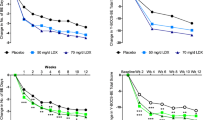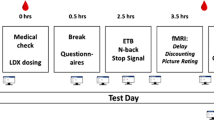Abstract
Background:
Tesofensine (TE) is a new drug producing twice the weight loss in obese individuals as seen with currently marketed drugs. It inhibits the presynaptic reuptake of the neurotransmitters noradrenaline, dopamine and serotonin, and is thought to enhance the neurotransmission of all three monoamines. The mechanisms by which it produces weight loss in humans are unresolved.
Objective:
The aim of this study is to investigate the mechanism(s) behind weight reduction by measuring energy expenditure and appetite sensations in overweight and obese individuals.
Design:
Thirty-two healthy, overweight or moderately obese men were treated with 2.0 mg TE daily for 7 days followed by an additional 7 days with 1.0 mg TE daily or corresponding placebo (PL) in a randomized, controlled trial. They were instructed to maintain habitual food intake and physical activity throughout. Twenty-four-hour energy expenditure (24-h EE), fat oxidation and spontaneous physical activity were measured in a respiration chamber before and after treatment. Body composition was assessed by dual-energy X-ray absorption and appetite was evaluated by visual analogue scales in conjunction with a standardized dinner.
Results:
Despite efforts to keep body weight and composition constant, TE induced a 1.8 kg weight loss above PL after 2 weeks’ treatment (P<0.0001). TE also induced higher ratings of satiety and fullness and concomitantly lower prospective food intake than placebo. No significant effect of TE on total 24-h EE could be demonstrated compared with PL, but higher energy expenditure was observed during the night period (4.6%; P<0.05) when adjusted for changes in body composition. Furthermore, TE increased 24-h fat oxidation as compared with PL (18 g; P<0.001).
Conclusion:
TE has a pronounced effect on appetite sensations and a slight effect on energy expenditure at night—both effects can contribute to the strong weight-reducing effect of TE.
This is a preview of subscription content, access via your institution
Access options
Subscribe to this journal
Receive 12 print issues and online access
$259.00 per year
only $21.58 per issue
Buy this article
- Purchase on Springer Link
- Instant access to full article PDF
Prices may be subject to local taxes which are calculated during checkout


Similar content being viewed by others
References
Ogden CL, Yanovski SZ, Carroll MD, Flegal KM . The epidemiology of obesity. Gastroenterology 2007; 132: 2087–2102.
Ogden CL, Carroll MD, Curtin LR, McDowell MA, Tabak CJ, Flegal KM . Prevalence of overweight and obesity in the United States, 1999–2004. JAMA 2006; 295: 1549–1555.
Curioni CC, Lourenco PM . Long-term weight loss after diet and exercise: a systematic review. Int J Obes (Lond) 2005; 29: 1168–1174.
Shaw K, Gennat H, O’Rourke P, Del MC . Exercise for overweight or obesity. Cochrane Database Systemic Reviews 2006; Issue No. 4, Art. no.: CD003817.
Wing RR, Hill JO . Successful weight loss maintenance. Annu Rev Nutr 2001; 21: 323–341.
Thatte U . NS-2330 (Neurosearch). Curr Opin Investig Drugs 2001; 2: 1592–1594.
Ayyad C, Andersen T . Long-term efficacy of dietary treatment of obesity: a systematic review of studies published between 1931 and 1999. Obes Rev 2000; 1: 113–119.
Hansen DL, Toubro S, Stock MJ, Macdonald IA, Astrup A . Thermogenic effects of sibutramine in humans. Am J Clin Nutr 1998; 68: 1180–1186.
Hansen DL, Toubro S, Stock MJ, Macdonald IA, Astrup A . The effect of sibutramine on energy expenditure and appetite during chronic treatment without dietary restriction. Int J Obes 1999; 23: 1016–1024.
Li ZP, Maglione M, Tu WL, Mojica W, Arterburn D, Shugarman LR et al. Meta-analysis: pharmacologic treatment of obesity. Ann Intern Med 2005; 142: 532–546.
Astrup A, Meier DH, Mikkelsen BO, Villumsen JS, Larsen TM . Weight loss produced by tesofensine in patients with Parkinson's or Alzheimer's disease. Obesity 2008; 16: 1363–1369.
Astrup A, Madsbad S, Breum L, Jensen TJ, Kroustrup JP, Larsen TM . Effect of tesofensine on bodyweight loss, body composition, and quality of life in obese patients: a randomised, double-blind, placebo-controlled trial. Lancet 2008; 372: 1906–1913.
Hansen H, Hansen G, Tang-Christensen M, Larsen PJ, Axel AM, Raben A et al. The novel triple monoamine reuptake inhibitor tesofensine induces sustained weight loss and improves glycemic control in the diet-induced obese rat: comparison to sibutramine and rimonabant. Eur J Pharmacol 2010; e-pub ahead of print 10 April 2010.
Astrup A, Thorbek G, Lind J, Isaksson B . Prediction of 24-H energy-expenditure and its components from physical characteristics and body-composition in normal-weight humans. Am J Clin Nutr 1990; 52: 777–783.
Toubro S, Christensen NJ, Astrup A . Reproducibility of 24-h energy expenditure, substrate utilization and spontaneous physical activity in obesity measured in a respiration chamber. Int J Obes Relat Metab Disord 1995; 19: 544–549.
Elia M, Livesey G . Energy expenditure and fuel selection in biological systems: the theory and practice of calculations based on indirect calorimetry and tracer methods. World Rev Nutr Diet 1992; 70: 68–131.
Klausen B, Toubro S, Astrup A . Age and sex effects on energy expenditure. Am J Clin Nutr 1997; 65: 895–907.
Flint A, Raben A, Blundell JE, Astrup A . Reproducibility, power and validity of visual analogue scares in assessment of appetite sensations in single test meal studies. Int J Obes 2000; 24: 38–48.
Buffenstein R, Karklin A, Driver HS . Beneficial physiological and performance responses to a month of restricted energy intake in healthy overweight women. Physiol Behav 2000; 68: 439–444.
Toubro S, Christensen NJ, Astrup A . Reproducibility of 24-H energy-expenditure, substrate utilization and spontaneous physical-activity in obesity measured in a respiration chamber. Int J Obes 1995; 19: 544–549.
Toubro S, Sorensen TI, Ronn B, Christensen NJ, Astrup A . Twenty-four-hour energy expenditure: the role of body composition, thyroid status, sympathetic activity, and family membership. J Clin Endocrinol Metab 1996; 81: 2670–2674.
Astrup A, Andersen T, Henriksen O, Christensen NJ, Bulow J, Madsen J et al. Impaired glucose-induced thermogenesis in skeletal muscle in obesity. The role of the sympathoadrenal system. Int J Obes 1987; 11: 51–66.
Astrup A, Buemann B, Christensen NJ, Madsen J . 24-hour energy expenditure and sympathetic activity in postobese women consuming a high-carbohydrate diet. Am J Physiol 1992; 262: E282–E288.
Westerterp KR, Donkers JHHL, Fredrix EWHM, Boekhoudt P . Energy-intake, physical-activity and body-weight—a simulation-model. Br J Nutr 1995; 73: 337–347.
Nelson DL, Gehlert DR . Central nervous system biogenic amine targets for control of appetite and energy expenditure. Endocrine 2006; 29: 49–60.
Connoley IP, Liu YL, Frost I, Reckless IP, Heal DJ, Stock MJ . Thermogenic effects of sibutramine and its metabolites. Br J Pharmacol 1999; 126: 1487–1495.
Golozoubova V, Strauss F, Malmlof K . Locomotion is the major determinant of sibutramine-induced increase in energy expenditure. Pharmacol Biochem Behav 2006; 83: 517–527.
Axel AM, Mikkelsen JD, Hansen HH . Tesofensine, a novel triple monoamine reuptake inhibitor, induces appetite suppression by indirect stimulation of alpha(1) adrenoceptor and dopamine D(1) receptor pathways in the diet-induced obese rat. Neuropsychopharmacology 2010; e-pub ahead of print 3 March 2010.
Lehr T, Staab A, Tillmann C, Nielsen EO, Trommeshauser D, Schaefer HG et al. Contribution of the active metabolite M1 to the pharmacological activity of tesofensine in vivo: a pharmacokinetic-pharmacodynamic modelling approach. Br J Pharmacol 2008; 153: 164–174.
Gasteyger C, Sjödin A, Meier DH, Astrup A . Effects of tesofensine on appetite in obese subjects. Obesity 2008; 16: S138–S139 (abstract).
Leibel RL, Rosenbaum M, Hirsch J . Changes in energy expenditure resulting from altered body weight. N Engl J Med 1995; 332: 621–628.
Prentice AM, Goldberg GR, Jebb SA, Black AE, Murgatroyd PR . Physiological-responses to slimming. Proc Nutr Soc 1991; 50: 441–458.
Ravussin E, Lillioja S, Knowler WC, Christin L, Freymond D, Abbott WG et al. Reduced rate of energy expenditure as a risk factor for body-weight gain. N Engl J Med 1988; 318: 467–472.
Astrup A, Gotzsche PC, van de Werken K, Ranneries C, Toubro S, Raben A et al. Meta-analysis of resting metabolic rate in formerly obese subjects. Am J Clin Nutr 1999; 69: 1117–1122.
Acknowledgements
We thank John Lind (technician) and Nathalie Bendsen (PhD student) for their help in collecting the data. The study was financed by NeuroSearch AS, Denmark.
Author information
Authors and Affiliations
Corresponding author
Ethics declarations
Competing interests
AA and JDM receive an honorarium as a consultant and AA is a member of the Tesofensine Advisory Board for NeuroSearch A/S. AR and DM are employees of NeuroSearch A/S and own shares in the company. J-KSJ works as a consultant for NeuroSearch A/S. CG is presently employed by Merck Serono, Switzerland, while AS and ALHN have no conflict of interest.
Rights and permissions
About this article
Cite this article
Sjödin, A., Gasteyger, C., Nielsen, AL. et al. The effect of the triple monoamine reuptake inhibitor tesofensine on energy metabolism and appetite in overweight and moderately obese men. Int J Obes 34, 1634–1643 (2010). https://doi.org/10.1038/ijo.2010.87
Received:
Revised:
Accepted:
Published:
Issue Date:
DOI: https://doi.org/10.1038/ijo.2010.87
Keywords
This article is cited by
-
Long-Term Efficacy and Safety of Anti-Obesity Treatment: Where Do We Stand?
Current Obesity Reports (2021)
-
The Fight Against Obesity Escalates: New Drugs on the Horizon and Metabolic Implications
Current Obesity Reports (2020)
-
Identification of key candidate genes and molecular pathways in white fat browning: an anti-obesity drug discovery based on computational biology
Human Genomics (2019)
-
Pharmacotherapy of Obesity: Limits and Perspectives
American Journal of Cardiovascular Drugs (2019)
-
Centrally Acting Agents for Obesity: Past, Present, and Future
Drugs (2018)



